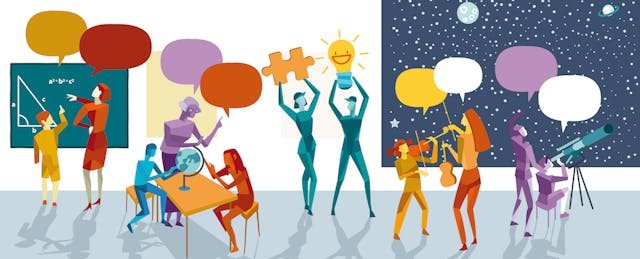We rarely accept “sit and get” instruction as ideal for our students. So why is it still the most common form of professional development for teachers across the country?
Even though educators acknowledge the weaknesses of presentation-based professional development, 80 percent of teachers still participate in a sit and get each year. As part of our research on what PD should look like, we found that both teachers and administrators value the same things in professional development—and it’s not sitting and getting. In a nutshell, they want professional learning opportunities that are:
- Relevant. As with students, teachers’ professional learning needs are rarely one-size-fits-all. “It looks different in every context,” one teacher told us. “It has to be personalized.”
- Interactive. Rather than listening to lectures, teachers want to apply learning through demonstrations or modeling and practice. “The best usually involve hands-on strategies for the teacher to actually participate in,” shared another teacher.
- Delivered by someone who understands their experience. Teachers value learning most when it comes from other teachers. “Anything that a fellow teacher who is still in the classroom [presents] beats out everything else,” one educator said. Another was more pointed about ideal PD opportunities: “Top-down would be gone.”
- Sustained over time. Professional growth is a process, not an hour blocked off on a calendar. “PD needs to be something that you keep working on for a semester or a year,” explained a teacher.
- Treats teachers like professionals. As one teacher told us, “PD should treat us as adults, rather than children.” As obvious as this point is, it doesn’t seem to be reflected in the reality of PD for most teachers—fewer than one in three are highly satisfied with current PD offerings.
The good news is that we know what this kind of ideal professional development should look like. A growing body of research is singling out two kinds of PD with the potential to check all these boxes and impact student achievement: coaching and collaboration. As a result, school systems and building leaders alike have focused efforts on coaching, feedback from observations, and professional learning communities, or PLCs, which bring teachers together to address common issues or learnings.
But there’s a catch. After talking with more than 1,300 teachers, professional development leaders, principals, and experts, we were surprised by one thing: While these forms of collaborative PD are backed by research and highly valued by school leaders, teachers are far from satisfied with their implementation to date.
For a more detailed image with footnotes, read Teachers Know Best: Teachers' Views on Professional Development, Bill & Melinda Gates Foundation.
Coaching is a perfect example. While it’s become a priority in many schools and districts, the reality is that fewer than half of all teachers are coached over the course of a year. The majority of in-school coaching is focused on new and struggling teachers, a practice that attaches a stigma to the process. As one teacher said, “I got told I was going to be meeting with the district reading coach. I thought, ‘Oh no, they’re talking about me at the district.’”
Additionally, the teachers who do receive coaching may not receive it on a regular, intensive basis. In fact, teachers are more likely to receive coaching monthly or a few times a month (33 percent) or even less frequently (27 percent) than they are to receive it weekly or more often (24 percent).
Teachers also are skeptical about administrators who serve as coaches. Instead, they prefer coaches who are subject-area experts trained in giving feedback and capable of sharing specific actions that can be tried in the classroom immediately. “Most [administrators] don’t have enough classroom seat time to coach teachers,” one educator explained.
Administrators also take on the lion’s share of observations. While new evaluation systems mean that teachers are getting observed more often than in the past, the teachers we spoke with say these observations rarely generate feedback that can help them improve. As one teacher put it, “we all get observed by the administration. There’s written feedback that comes with it. But not mentoring, coaching, pairing.”
But it is the chasm between the potential of teacher collaboration and what it looks like today that’s arguably the most striking. While teachers value collaboration with their peers, they say that current efforts like PLCs often lack engagement and are poorly planned or executed. Specifically, teachers typically find little help with:
- Planning lessons
- Identifying daily and weekly learning objectives
- Developing teaching skills and content knowledge
- Activities such as debriefing student behavior issues and communicating rules and procedures
In short, current collaborative activities too often seem like a waste of time. “Feels like I’m being held hostage,” one teacher said.
Yet in schools with strong models for collaboration, teachers report being dramatically more satisfied in their day-to-day work than their peers elsewhere. They say they feel prepared to take on big challenges, including new standards, the use of data, and differentiated instruction.
What do these schools look like? They often have:
- Formal collaboration time built into master schedules
- Shared instructional planning responsibilities
- Clearly defined grade-level and subject-area teams that work well with each other
But there aren’t many of them: Fewer than seven percent of teachers said their schools fit these descriptions. For too many teachers, PD is still seen as a compliance activity that’s little better than sit and get. “Can do better at home in my living room,” one said.
Creating the kinds of collaborative learning opportunities educators want isn’t easy, but given that on average teachers spend more than a week per year on professional learning activities, we owe it to them to find new ways to ensure that PD is relevant, interactive, and sustained over time. Identifying key use cases for technology and other activities that might not be labeled as PD today are among the opportunities; teachers’ desire to work together provides a goal to work towards and a roadmap to getting there. In our next article, we’ll look more closely at how one district began this process.



